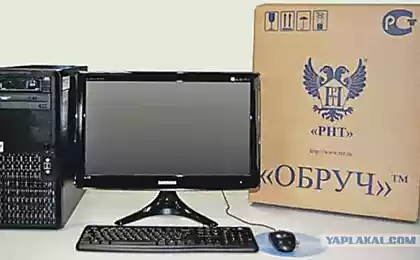776
New Russian computers
There is a lot of text, as the finish will tell. And so it went ...
Tyts
So in Russia ZAO "MCST" and JSC "INEUM them. Bruk "9 International Exhibition« ChipExpo-2011 ", held in Moscow in the period from 1 to 3 November 2011 in the Central Exhibition Complex" Expocentre ", demonstrate the new processors, personal computers, laptops and other electronics working on microelectronics and processor of its own production.
Computers are basically to: industry of civil proceedings; military departments of Russia, CIS and BRIC; civil radar systems (sea, air, land transport). For civilians and businesses, where it is necessary to establish specially protected computers and reliable. Computers have a different design concept. Different classes of security depending on the need. All computers have the support or the opportunity to work with GLONASS and GPS, depending on the needs of the buyer.
In this paper, I will try to explain the principles of the Russian computers and processors, as well as, the application of new products.
So briefly go through the novelties, then Let us examine the details and peculiarities of Russian processors and how they compare.
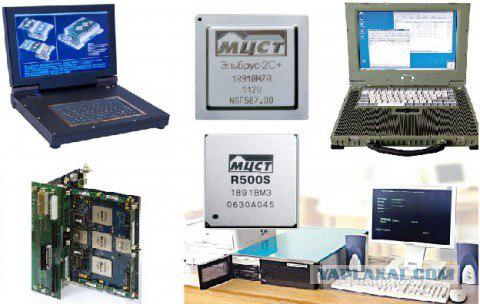
Elbrus-2C + - the first hybrid high-performance microprocessor company MCST. It contains 2 core architecture Elbrus and 4 core digital signal processor (DSP) the company Elvis. The main application processor Elbrus-2C + - system of digital intelligent signal processing, such as radar, image analyzer, and the like
In comparison with the processor Elbrus-S, the processor Elbrus-2C + was introduced the following changes:
Cores architecture Elbrus increased to 2.
Cache Level 2 is reduced to 1 MB per core.
Added a cluster of four DSP cores, operating on the same frequency.
The supported memory type is changed to DDR2-800, throughput has improved by 60%
Added another channel IO. You can connect an additional Southbridge KPI or a dedicated device such as a controller DAC / ADC.
For the hybrid version of the processor is implemented with the C language compiler that allows you to compile the code for DSP cores and ensure effective communication of the main program, executed on cores CPU, and procedures for the DSP.
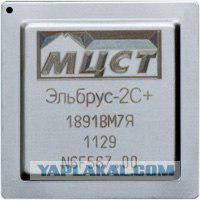
The main characteristics of the system-on-chip Elbrus-2C +
Characteristics values
1 Process Technology 90 nm
2 500 MHz
3 Cores architecture Elbrus 2
Cores DSP (Elcore-09) 4
Peak performance chips (CPU + kernel core DSP)
64-bit, GIPS 20+ 2
64-bit, GFlops 8 +0
32-bit, GIPS 33 +16
32-bit, GFlops 16 +12
16-bit, GIPS 43 +48
5.Kesh memory command (to the core), CB 64
6.Kesh-memory data (the core), CB 64
7.Kesh memory of the second level (to the core), 1 MB
8.Vstroennaya memory DSP (per core DSP), 128 KB
9.Propusknaya of the bus due to the cache memory, GB / 16
10.Propusknaya capacity of tires due to the RAM, GB / 12, 8
11.Kolichestvo interprocessor exchange channels 3
The bandwidth interprocessor exchange GB / 4
Number of input-output channels 2
The bandwidth IO GB / 2
12 die size, mm2 289
13 Number of Transistors 368 million
14 The number of metal layers 9
15 Enclosure Type / number of pins HFCBGA 1296
16 Dimensions of the housing 37, 5h37, 5 mm
17 Power Supply, 1, 0/1, 8/2, 5
18
Average power dissipation
~ 25W
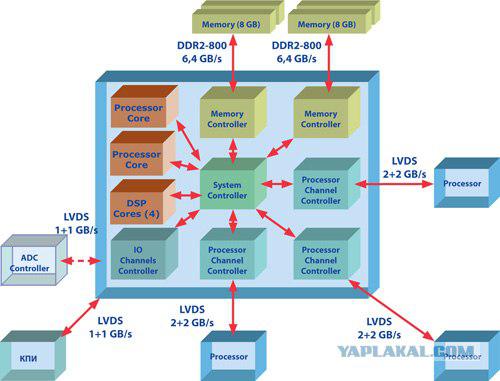
The latest 4 core microprocessor "MCST R1000» («MCST-4R» working title)
IC "MCST-4R» is a quad system on a chip with built-in shared second-level cache and controller coherence controller channel input-output, switch and system controller intersystem exchange. The chip is based on the previously developed in ZAO "MCST" system-on-chip «R-500S»
The chip and developed on its base processor modules MVS4 / C MVS4-PC designed for use in compatible with the EC "Elbrus-90mikro" high-performance computer systems for automated control systems, as well as to create a high-performance single-board computers of portable and embedded applications.
Possible fields of application chips "MCST-4R» and modules MVS4 / C MVS4-MS include:
Portable compact home computers to be used as:
a computer for use in the field, in particular for operational calculations, storing reference information, preparation of documents for various purposes, etc .;
terminal electronic and communication systems, mobile and wearable systems equipment,
terminal control and test equipment in technical positions, as well as the storage and preparation of documents related to the operation of complex systems, etc. applications.
Computer Aided operator workstations for use as a means of mapping, documentation of the work performed, and others.
Embedded control computers for solving problems of information processing and management of special objects in real time
Class Mobile fault tolerant servers to build automated systems spetsialnogo.naznacheniya, in particular the AU organs of civil and military administration.
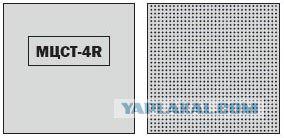
Key Features chips "MCST-4R»
Characteristics values
1. The processor core organization of the nucleus - superscalar, decoding and execution of two instructions per clock cycle
Number of processor cores - 4
Clock Speed - 1 GHz
2.Proizvoditelnost, GIPS / GFLOPS 4 / 1.6
3.Vnutrennyaya cache memory cache of the first level:
Team - 16K *,
Information - 32 KB *
Cache of the second level - 1.5 MB
4.Operativnaya memory capacity - up to 8 GB,
Channel capacity - 4.5 GB / s
5.Kanal remote access to the I output: Number of channels - 1
Channel type - Duplex
The capacity of the channel in one direction - 2 GB / s
6.Kanal intersystem exchange: Number of channels - 3
Channel type - Duplex
The capacity of the channel in one direction - 2 GB / s
7.Potreblyaemaya power, W ~ 10 **
8.Kolichestvo transistors, mln. Pcs. ~ 150 **
9.Napryazhenie Supply, 1, 0 for internal circuits,
2, 5 and 3, 3 to the periphery
10. The housing Number of outputs - 900 **
11. Technology CMOS 0, 09 mm, 8 layers of metal
12. The area of the crystal, ~ 10x10 mm2 **
13.
* - Data from one processor ** - to be confirmed in the design
CPU0 ... CPU3 - four processing cores;
L2 cache - the cache memory of the second level;
CC - coherence controller
MC - controller RAM DDR2 SDRAM;
IOCC - channel controller IO;
ISCC - Controllers intersystem exchange;
SCom - system switch.
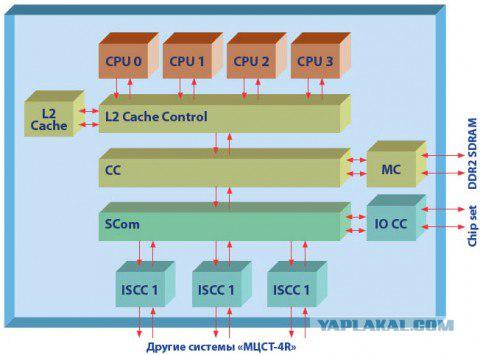
Embedded Systems (modules) and finished products based on microprocessor MCST R500S
For industrial applications, the module developed CBM / C. The module is in the format "Euromechanics" with a height of 3U CompactPCI bus and has all the necessary components: processor, memory, graphics card, hard drive, external interfaces.
rotsessor MCST R500S, 500 MHz
Memory DDR, 1GB
Video Controller own development (MGA), 2 independent channels, resolution up to 1600x1200 at 24-bit color. 2x8 MB video buffer outputs DVI-I and VGA
Interfaces (external and exit to the rear system connector) USB2.0 (4 channel), PCI (32bit / 33MHz), stereo audio, SATA 1.0 (3 channels), GBit Ethernet (2 channels), RS232, PS / 2 (2 Channel Kb & M)
Power supply 5 V, 20 W

MCST has developed a model of a thin client with small size and power consumption
A thin client is a device input and display (terminal / mini computer). Physically, the thin client is a compact and silent computer without a hard disk (without fans), loading the primary operating system which occurs on the server. All user applications run on the terminal server (application server), but the user is completely transparent. Since all the computational burden falls on the server, thin client has the minimum hardware configuration without sacrificing performance.
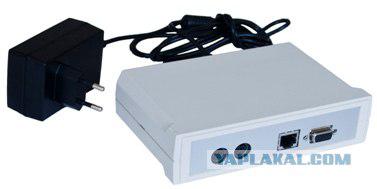
Source:
Tyts
So in Russia ZAO "MCST" and JSC "INEUM them. Bruk "9 International Exhibition« ChipExpo-2011 ", held in Moscow in the period from 1 to 3 November 2011 in the Central Exhibition Complex" Expocentre ", demonstrate the new processors, personal computers, laptops and other electronics working on microelectronics and processor of its own production.
Computers are basically to: industry of civil proceedings; military departments of Russia, CIS and BRIC; civil radar systems (sea, air, land transport). For civilians and businesses, where it is necessary to establish specially protected computers and reliable. Computers have a different design concept. Different classes of security depending on the need. All computers have the support or the opportunity to work with GLONASS and GPS, depending on the needs of the buyer.
In this paper, I will try to explain the principles of the Russian computers and processors, as well as, the application of new products.
So briefly go through the novelties, then Let us examine the details and peculiarities of Russian processors and how they compare.

Elbrus-2C + - the first hybrid high-performance microprocessor company MCST. It contains 2 core architecture Elbrus and 4 core digital signal processor (DSP) the company Elvis. The main application processor Elbrus-2C + - system of digital intelligent signal processing, such as radar, image analyzer, and the like
In comparison with the processor Elbrus-S, the processor Elbrus-2C + was introduced the following changes:
Cores architecture Elbrus increased to 2.
Cache Level 2 is reduced to 1 MB per core.
Added a cluster of four DSP cores, operating on the same frequency.
The supported memory type is changed to DDR2-800, throughput has improved by 60%
Added another channel IO. You can connect an additional Southbridge KPI or a dedicated device such as a controller DAC / ADC.
For the hybrid version of the processor is implemented with the C language compiler that allows you to compile the code for DSP cores and ensure effective communication of the main program, executed on cores CPU, and procedures for the DSP.

The main characteristics of the system-on-chip Elbrus-2C +
Characteristics values
1 Process Technology 90 nm
2 500 MHz
3 Cores architecture Elbrus 2
Cores DSP (Elcore-09) 4
Peak performance chips (CPU + kernel core DSP)
64-bit, GIPS 20+ 2
64-bit, GFlops 8 +0
32-bit, GIPS 33 +16
32-bit, GFlops 16 +12
16-bit, GIPS 43 +48
5.Kesh memory command (to the core), CB 64
6.Kesh-memory data (the core), CB 64
7.Kesh memory of the second level (to the core), 1 MB
8.Vstroennaya memory DSP (per core DSP), 128 KB
9.Propusknaya of the bus due to the cache memory, GB / 16
10.Propusknaya capacity of tires due to the RAM, GB / 12, 8
11.Kolichestvo interprocessor exchange channels 3
The bandwidth interprocessor exchange GB / 4
Number of input-output channels 2
The bandwidth IO GB / 2
12 die size, mm2 289
13 Number of Transistors 368 million
14 The number of metal layers 9
15 Enclosure Type / number of pins HFCBGA 1296
16 Dimensions of the housing 37, 5h37, 5 mm
17 Power Supply, 1, 0/1, 8/2, 5
18
Average power dissipation
~ 25W

The latest 4 core microprocessor "MCST R1000» («MCST-4R» working title)
IC "MCST-4R» is a quad system on a chip with built-in shared second-level cache and controller coherence controller channel input-output, switch and system controller intersystem exchange. The chip is based on the previously developed in ZAO "MCST" system-on-chip «R-500S»
The chip and developed on its base processor modules MVS4 / C MVS4-PC designed for use in compatible with the EC "Elbrus-90mikro" high-performance computer systems for automated control systems, as well as to create a high-performance single-board computers of portable and embedded applications.
Possible fields of application chips "MCST-4R» and modules MVS4 / C MVS4-MS include:
Portable compact home computers to be used as:
a computer for use in the field, in particular for operational calculations, storing reference information, preparation of documents for various purposes, etc .;
terminal electronic and communication systems, mobile and wearable systems equipment,
terminal control and test equipment in technical positions, as well as the storage and preparation of documents related to the operation of complex systems, etc. applications.
Computer Aided operator workstations for use as a means of mapping, documentation of the work performed, and others.
Embedded control computers for solving problems of information processing and management of special objects in real time
Class Mobile fault tolerant servers to build automated systems spetsialnogo.naznacheniya, in particular the AU organs of civil and military administration.

Key Features chips "MCST-4R»
Characteristics values
1. The processor core organization of the nucleus - superscalar, decoding and execution of two instructions per clock cycle
Number of processor cores - 4
Clock Speed - 1 GHz
2.Proizvoditelnost, GIPS / GFLOPS 4 / 1.6
3.Vnutrennyaya cache memory cache of the first level:
Team - 16K *,
Information - 32 KB *
Cache of the second level - 1.5 MB
4.Operativnaya memory capacity - up to 8 GB,
Channel capacity - 4.5 GB / s
5.Kanal remote access to the I output: Number of channels - 1
Channel type - Duplex
The capacity of the channel in one direction - 2 GB / s
6.Kanal intersystem exchange: Number of channels - 3
Channel type - Duplex
The capacity of the channel in one direction - 2 GB / s
7.Potreblyaemaya power, W ~ 10 **
8.Kolichestvo transistors, mln. Pcs. ~ 150 **
9.Napryazhenie Supply, 1, 0 for internal circuits,
2, 5 and 3, 3 to the periphery
10. The housing Number of outputs - 900 **
11. Technology CMOS 0, 09 mm, 8 layers of metal
12. The area of the crystal, ~ 10x10 mm2 **
13.
* - Data from one processor ** - to be confirmed in the design
CPU0 ... CPU3 - four processing cores;
L2 cache - the cache memory of the second level;
CC - coherence controller
MC - controller RAM DDR2 SDRAM;
IOCC - channel controller IO;
ISCC - Controllers intersystem exchange;
SCom - system switch.

Embedded Systems (modules) and finished products based on microprocessor MCST R500S
For industrial applications, the module developed CBM / C. The module is in the format "Euromechanics" with a height of 3U CompactPCI bus and has all the necessary components: processor, memory, graphics card, hard drive, external interfaces.
rotsessor MCST R500S, 500 MHz
Memory DDR, 1GB
Video Controller own development (MGA), 2 independent channels, resolution up to 1600x1200 at 24-bit color. 2x8 MB video buffer outputs DVI-I and VGA
Interfaces (external and exit to the rear system connector) USB2.0 (4 channel), PCI (32bit / 33MHz), stereo audio, SATA 1.0 (3 channels), GBit Ethernet (2 channels), RS232, PS / 2 (2 Channel Kb & M)
Power supply 5 V, 20 W

MCST has developed a model of a thin client with small size and power consumption
A thin client is a device input and display (terminal / mini computer). Physically, the thin client is a compact and silent computer without a hard disk (without fans), loading the primary operating system which occurs on the server. All user applications run on the terminal server (application server), but the user is completely transparent. Since all the computational burden falls on the server, thin client has the minimum hardware configuration without sacrificing performance.

Source:




















